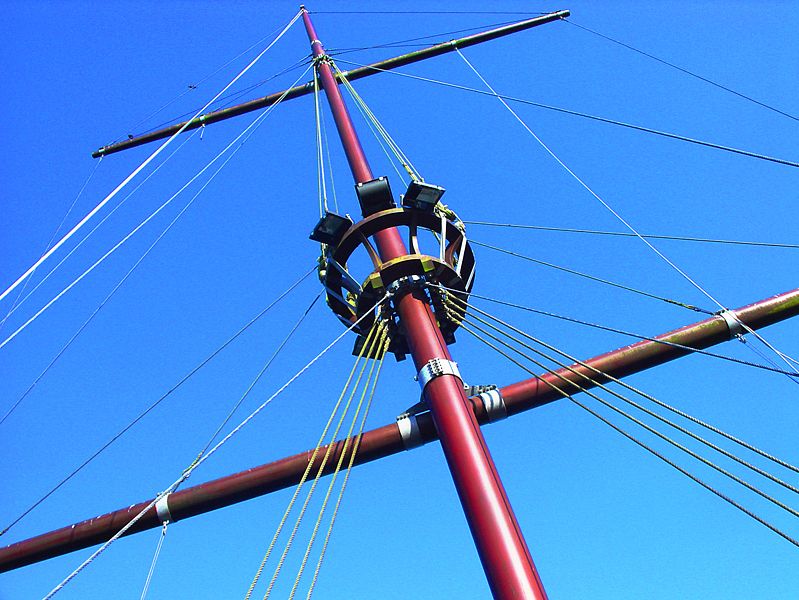One way to think about spinal stability is that it is made up of three different components: the spine itself, the muscles surrounding the spine, and the circuitry that is in charge of firing these muscles (11). The neural control unit is the circuitry that coordinates the muscle activity to respond to both expected and unexpected forces. For appropriate spinal stability, this system must fire the right muscles, at the right time, by the right amount, to protect the spine from injury while still allowing the desired movement (1). The muscles surrounding the spine are like the "rigging on a ship's mast," and as such an inappropriate magnitude from just one of them could perturb the fine balance of the mast (10).
 STOP! Don't pick up that pen!
The neural control unit, when functioning correctly, orchestrates muscle contraction so precisely that if you were to reach your arm out very quickly, say, to catch an unexpected pass, this system can fire certain stabilizing muscles—like your abs—even before the muscles responsible for the arm movement itself (7, 8).
When this system is functioning correctly, it can orchestrate the precise balance of the muscle activity around the spine such that contractions as low as 1-3% of a muscle's maximal voluntary contraction may be sufficient to provide dynamic stability (4), and contractions as low as 25% of a muscle's maximal voluntary contraction are able to provide maximal joint stiffness between the vertebrae (14).
But this system does not always function correctly. More on that later.
STOP! Don't pick up that pen!
The neural control unit, when functioning correctly, orchestrates muscle contraction so precisely that if you were to reach your arm out very quickly, say, to catch an unexpected pass, this system can fire certain stabilizing muscles—like your abs—even before the muscles responsible for the arm movement itself (7, 8).
When this system is functioning correctly, it can orchestrate the precise balance of the muscle activity around the spine such that contractions as low as 1-3% of a muscle's maximal voluntary contraction may be sufficient to provide dynamic stability (4), and contractions as low as 25% of a muscle's maximal voluntary contraction are able to provide maximal joint stiffness between the vertebrae (14).
But this system does not always function correctly. More on that later.
 Spinal muscles; yeah, kinda like this.
The spine itself—and its associated ligamentous structures—also play a role in spinal stability, albeit a passive role. The bony structures of your spine, and the ligaments that connect them together, and the elastomer-like disks that separate the bony structures, all add to stability by providing passive restraint toward the end of the range of motion; they resist movement to prevent the spine from going too far in one direction.
A lumbar spine from a cadaver in which the muscles have been removed will buckle under only about 20 pounds (5), so it may seem like this passive system is a relatively less important system than the active muscles. But in addition to their passive properties, the ligaments and disks also have active properties: nerves have been described in ligaments and intervertebral tissues that can actually send out signals to the muscles when they are stretched, to dramatically improve the sensitivity of the muscular response.
Moreover, as is true with other systems in the body, a dysfunction in one of the stabilizing systems of the spine would not necessarily ruin the whole system; it has been suggested that these systems are interdependent, and that when one of them is dysfunctional another can compensate in its place (11, 12).
So a dysfunction in just one of these systems may not lead to you throwing out your back while bending down to pick up a pencil, but it would certainly make you more susceptible to doing so.
If there were a dysfunction in any of the major muscles, there are several superficial, intermediate, and deep muscles that could theoretically provide some level of compensatory lumbar stability because of their lumbar attachments.
For example, the quadratus lumborum muscle is not the only muscle that can laterally bend the vertebral column; the interspinales, intertransversarii mediales, multifidi, and lumbar erector spinae can all perform the same function (6).
But if the activity in these muscles is any more than just 10% of their maximal voluntary contraction, this could lead to unnecessary muscle fatigue over the course of an entire day and subsequent tightness or even injury (4). If you have a deficiency in the bone and ligamentous system, you can also compensate with additional muscle activation to increase spinal stability, but this too may lead to muscle fatigue and pain.
Dysfunctions in the neural control unit's ability to maintain spinal stability have also been suggested as possible causes of some lower back disorders and chronic back pain (3, 11). Healthy people may be able to rely on the passive stabilizing properties of the spine during standing or sitting, but patients with a clinical deficiency in the stabilizing system, such as a nerve injury, need to sustain static prolonged muscle contractions throughout the day (3).
Additionally, people with a nerve injury may even have a disruption in their ability to recruit the necessary muscular activity to stabilize the spinal segments immediately above and below the injured segment and therefore may be susceptible to further injury, such as progressive deformation or further neurological damage (13, 15).
So increased levels of muscle activation may be an objective indicator of a dysfunction in either the bone and ligamentous system, or the neural control unit (4).
With all this considered, it is not surprising that people can sustain a back injury in a seemingly simple task such as picking up a pencil.
In this situation, muscular forces and stiffness requirements are low, but if the neural control unit committed a small error in the activation sequence or the magnitude, even from a single small muscle, instability and subsequent injury could result from this temporary loss of stiffness (10).
Spinal muscles; yeah, kinda like this.
The spine itself—and its associated ligamentous structures—also play a role in spinal stability, albeit a passive role. The bony structures of your spine, and the ligaments that connect them together, and the elastomer-like disks that separate the bony structures, all add to stability by providing passive restraint toward the end of the range of motion; they resist movement to prevent the spine from going too far in one direction.
A lumbar spine from a cadaver in which the muscles have been removed will buckle under only about 20 pounds (5), so it may seem like this passive system is a relatively less important system than the active muscles. But in addition to their passive properties, the ligaments and disks also have active properties: nerves have been described in ligaments and intervertebral tissues that can actually send out signals to the muscles when they are stretched, to dramatically improve the sensitivity of the muscular response.
Moreover, as is true with other systems in the body, a dysfunction in one of the stabilizing systems of the spine would not necessarily ruin the whole system; it has been suggested that these systems are interdependent, and that when one of them is dysfunctional another can compensate in its place (11, 12).
So a dysfunction in just one of these systems may not lead to you throwing out your back while bending down to pick up a pencil, but it would certainly make you more susceptible to doing so.
If there were a dysfunction in any of the major muscles, there are several superficial, intermediate, and deep muscles that could theoretically provide some level of compensatory lumbar stability because of their lumbar attachments.
For example, the quadratus lumborum muscle is not the only muscle that can laterally bend the vertebral column; the interspinales, intertransversarii mediales, multifidi, and lumbar erector spinae can all perform the same function (6).
But if the activity in these muscles is any more than just 10% of their maximal voluntary contraction, this could lead to unnecessary muscle fatigue over the course of an entire day and subsequent tightness or even injury (4). If you have a deficiency in the bone and ligamentous system, you can also compensate with additional muscle activation to increase spinal stability, but this too may lead to muscle fatigue and pain.
Dysfunctions in the neural control unit's ability to maintain spinal stability have also been suggested as possible causes of some lower back disorders and chronic back pain (3, 11). Healthy people may be able to rely on the passive stabilizing properties of the spine during standing or sitting, but patients with a clinical deficiency in the stabilizing system, such as a nerve injury, need to sustain static prolonged muscle contractions throughout the day (3).
Additionally, people with a nerve injury may even have a disruption in their ability to recruit the necessary muscular activity to stabilize the spinal segments immediately above and below the injured segment and therefore may be susceptible to further injury, such as progressive deformation or further neurological damage (13, 15).
So increased levels of muscle activation may be an objective indicator of a dysfunction in either the bone and ligamentous system, or the neural control unit (4).
With all this considered, it is not surprising that people can sustain a back injury in a seemingly simple task such as picking up a pencil.
In this situation, muscular forces and stiffness requirements are low, but if the neural control unit committed a small error in the activation sequence or the magnitude, even from a single small muscle, instability and subsequent injury could result from this temporary loss of stiffness (10).
References 1. Barr KP, Griggs M, Cadby T. Lumbar stabilization: core concepts and current literature, Part 1. Am J Phys Med Rehabil. 2005 Jun;84(6):473-80. 2. Cholewicki J, McGill SM, Norman RW. Lumbar spine loads during the lifting of extremely heavy weights. Med Sci Sports Exerc. 1991 Oct;23(10):1179-86. 3. Cholewicki J, McGill SM. Mechanical stability of the in vivo lumbar spine: Implications for injury and chronic low back pain. Clin Biomech 1996;11:1-15. 4. Cholewicki J, Panjabi MM, Khachatryan A. Stabilizing function of trunk flexor-extensor muscles around a neutral spine posture. Spine. 1997 Oct 1;22(19):2207-12. 5. Crisco JJ, Panjabi MM, Yamamoto I, Oxland TR. Euler stability of the human ligamentous lumbar spine: Part II experiment. Clin Biomech 1992;7:27-32. 6. Hansen L, de Zee M, Rasmussen J, Andersen TB, Wong C, Simonsen EB. Anatomy and biomechanics of the back muscles in the lumbar spine with reference to biomechanical modeling. Spine. 2006 Aug 1;31(17):1888-99. 7. Hodges PW, Richardson CA. Contraction of the abdominal muscles associated with movement of the lower limb. Phys Ther. 1997a Feb;77(2):132-42; discussion 142-4. 8. Hodges PW, Richardson CA. Feedforward contraction of transverses abdominis is not influenced by the direction of arm movement. Exp Brain Res. 1997b Apr;114(2):362-70. 9. McGill SM, Norman RW. Partitioning of the L4-L5 dynamic moment into disc, ligamentous, and muscular components during lifting. Spine. 1986 Sep;11(7):666-78. 10. McGill, SM. Stability: from biomechanical concept to chiropractic practice. J Can Chiropr Assoc 1999; 43(2). 11. Panjabi MM. The stabilizing system of the spine. Part I. Function, dysfunction, adaptation, and enhancement. J Spinal Disord. 1992 Dec;5(4):383-9; discussion 397. 12. Panjabi MM. Clinical spinal instability and low back pain. J Electromyogr Kinesiol. 2003 Aug;13(4):371-9. 13. Pope M, Frymoyer J, Krag M. Diagnosing instability. Clin Orthop 1992;296:60-7. 14. Richardson CA, Jull GA. Muscle control-pain control. What exercises would you prescribe? Man Ther. 1995 Nov;1(1):2-10. 15. Solomonow M, Zhou BH, Harris M, Lu Y, Baratta RV. The Ligamento-Muscular Stabilizing System of the Spine. Spine. 1998 Dec 1;23(23):2552-62.





Comments